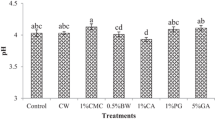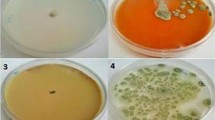Abstract
Lemon (Citrus limon L.) is one of the most cultivated citrus fruit in South Africa. In citrus packhouses, fruit are coated with commercial synthetic waxes to enhance shelflife. However, the use of waxes has been linked to peteca spot (PS) incidence in lemons. This study evaluated the efficacy of chitosan (CH) and carboxymethyl cellulose (CMC) incorporated with moringa leaf extracts (M) on reducing peteca spot incidence on ‘Eureka’ lemon. A total of 500 ‘Eureka’ lemons were harvested from outside and inside canopy positions from a commercial orchard in KwaZulu-Natal, South Africa. Fruit were assigned to five coating treatments, namely; control, 1% M + CMC, 1% CMC, 1% CH and 1% M + CH. After coating, fruit were transferred into a cold room with delivery air temperature set at 3 °C for 12 weeks to induce the disorder. At each sampling week, peteca spot incidence, fruit physicochemical and phytochemical properties including color, mass, vitamin C, carotenoids, TSS, TA and phenolics were measured. The results showed that coating treatments and canopy position significantly affected PS incidence. Fruit coated with M + CMC, CMC, CH were less susceptible to PS development in both inside and outside canopy compared to the control and M + CH coated fruit. Coating treatments significantly affected phenolic and flavonoid concentration. Moreover, coating treatments significantly reduced mass loss, ascorbic acid loss and delayed color change of fruit. The results found in this study demonstrated the ability of either M + CMC, CMC, or CH as coating treatments for reducing PS in ‘Eureka’ lemon.





Similar content being viewed by others
References
Abdel-Salam MM (2016) Improving grapefruit quality during storage life by using some coating materials on different temperature. Middle East J 5:29–36
Adetunji CO, Fawole OB, Arowora KA, Nwaubani SI, Oloke JK, Adepoju AO, Adetunji JB, Ajani AO (2013) Performance of edible coatings from carboxymethyl cellulose (CMC) and corn starch (CS) incorporated with moringa oleifera extract on citrus sinensis stored at ambient temperature. Agrosearch 13:77–86
Ali A, Muhammad MTM, Sijam K, Siddiqui Y (2011) Effect of chitosan coatings on the physicochemical characteristics of Eksotika II papaya (Carica papaya L.) fruit during cold storage. Food Chem 124:620–626
Arnon H, Granit R, Porat R, Poverenov E (2015) Development of polysaccharides-based edible coatings for citrus fruits: a layer-by-layer approach. Food Chem 166:465–472
Ben-Yehoshua S, Rodov V, Kim JJ, Carmeli S (1992) Preformed and induced antifungal materials of citrus fruits in relation to the enhancement of decay resistance by heat and ultraviolet treatments. J Agric Food Chem 40:1217–1221
Burdurlu HS, Koca N, Karadeniz F (2006) Degradation of vitamin C in citrus juice concentrates during storage. J Food Eng 74:211–216
Ćetković G, Čanadanović-Brunet J, Djilas S, Tumbas V, Markov S, Cvetković D (2007) Antioxidant potential, lipid peroxidation inhibition and antimicrobial activities of (Satureja montana L. subsp. Kitaibelii) extracts. Int J Mol Sci 8:1013–1027
CGA, Citrus Growers Association of Southern Africa (2018) Key industry statistics for citrus growers Key industry statistics CGA, 2018.pdf
Chien PJ, Chou CC (2006) Antifungal activity of chitosan and its application to control post-harvest quality and fungal rotting of Tankan citrus fruit (Citrus tankan Hayata). J Sci Food Agric 86:1964–1969
Corrêa LC, Santos CAF, Vianello F, Lima GPP (2011) Antioxidant content in guava (Psidium guajava) and araca (Psidium spp.) germplasm from different Brazilian regions. Plant Genet Resour 9:384–391
Cronje PJ (2015) Could ethylene metabolism in lemon fruit influence peteca incidence? Acta Hortic 1065:1455–1461
Cronje PJ, Barry GH, Huysamer M (2011) Postharvest rind breakdown of ‘Nules Clementine’ mandarin is influenced by ethylene application, storage temperature and storage duration. Postharvest Biol Technol 60:192–201
Cronje PJ, Barry GH, Huysamer M (2013) Canopy position affects pigment expression and accumulation of flavedo carbohydrates of ‘Nules Clementine’ mandarin fruit, thereby affecting rind condition. J Am Soc Hortic Sci 138:217–224
de Aquino AB, Blank AF, de Aquino Santana LCL (2015) Impact of edible chitosan–cassava starch coatings enriched with Lippia gracilis Schauer genotype mixtures on the shelf life of guavas (Psidium guajava L.) during storage at room temperature. Food Chemi 171:108–116
Dong X, Hu Y, Li Y, Zhou Z (2019) The maturity degree, phenolic compounds and antioxidant activity of Eureka lemon [Citrus limon (L.) Burm. f.]: a negative correlation between total phenolic content, antioxidant capacity and soluble solid content. Sci Hortic 243:281–289
Escobedo-Avellaneda Z, Gutiérrez-Uribe J, Valdez-Fragoso A, Torres JA, Welti-Chanes J (2014) Phytochemicals and antioxidant activity of juice, flavedo, albedo and comminuted orange. J Funct Foods 6:470–481
Hagen SF, Borge GIA, Bengtsson GB, Bilger W, Berge A, Haffner K, Solhaug KA (2007) Phenolic contents and other health and sensory related properties of apple fruit (Malus domestica Borkh., cv. Aroma): effect of postharvest UV-B irradiation. Postharvest Biol Technol 45:1–10
Han C, Zuo J, Wang Q, Xu L, Zhai B, Wang Z, Dong H, Gao L (2014) Effects of chitosan coating on postharvest quality and shelf life of sponge gourd (Luffa cylindrica) during storage. Sci Hortic 166:1–8
Hernández Y, Lobo MG, González M (2006) Determination of vitamin C in tropical fruits: a comparative evaluation of methods. Food Chem 96:654–664
Iglesias DJ, Cercós M, Colmenero-Flores JM, Naranjo MA, Ríos G, Carrera E, Ruiz-Rivero O, Lliso I, Morillon R, Tadeo FR, Talon M (2007) Physiology of citrus fruiting. Braz J Plant Physiol 19:333–362
Ilahy R, Hdider C, Lenucci MS, Tlili I, Dalessandro G (2011) Antioxidant activity and bioactive compound changes during fruit ripening of high-lycopene tomato cultivars. J Food Compos Anal 24:588–595
Irkin R, Dogan S, Degirmencioglu N, Diken ME, Guldas M (2015) Phenolic content, antioxidant activities and stimulatory roles of citrus fruits on some lactic acid bacteria. Arch Biol Sci 67:1313–1321
Kamtekar S, Keer V, Patil V (2014) Estimation of phenolic content, flavonoid content, antioxidant and alpha amylase inhibitory activity of marketed polyherbal formulation. J Appl Pharm Sci 4:61–65
Khalidy R, Jamali A, Bolkan H (1969) Causes of the peteca disease of lemons as occurring in Lebanon. In: Proceedings of international citrus symposium riverside, vol 3. University of California, California. Riverside, pp 1253–1261
Laing BM, Schlueter DL, Labuza TP (1978) Degradation kinetics of ascorbic acid at high temperature and water activity. J Food Sci 43:1440–1443
Lü Z, Zhang Z, Wu H, Zhou Z, Yu J (2016) Phenolic composition and antioxidant capacities of Chinese local pummelo cultivars’ peel. Hortic Plant J 2:133–140
Machado FLDC, Costa JMC, Batista EN (2012) Application of carnauba-based wax maintains postharvest quality of ‘Ortanique’ tangor. Food Sci Technol 32:261–268
Magwaza LS, Opara UL, Cronje PJ, Landahl S, Terry LA (2013) Canopy position affects rind biochemical profile of ‘Nules Clementine’ mandarin fruit during postharvest storage. Postharvest Biol Technol 86:300–308
Ncama K, Magwaza LS, Fawole OA, Tesfay SZ, Opara UL (2018) Investigating pre-symptomatic biochemical markers related to ‘Marsh’ grapefruit (Citrus × paradisi Macfad) susceptibility to chilling injury and rind pitting disorders. In: VII international conference on managing quality in chains and II international symposium on ornamentals, vol 1201, pp 131–138
Obenland D, Collin S, Sievert J, Fjeld K, Doctor J, Arpaia ML (2008) Commercial packing and storage of navel oranges alters aroma volatiles and reduces flavor quality. Postharvest Biol Technol 47:159–167
Olarewaju OO, Magwaza LS, Fawole OA, Tesfay SZ, Opara UL (2018) Comparative effects of canopy position on physicochemical properties of ‘Marsh’ grapefruit during non-chilling postharvest cold storage. Sci Hortic 241:1–7
Palou L, Valencia-Chamorro SA, Pérez-Gago MB (2015) Antifungal edible coatings for fresh citrus fruit: a review. Coatings 5:962–986
Rodrigues AS, Pérez-Gregorio MR, García-Falcón MS, Simal-Gándara J, Almeida DP (2010) Effect of post-harvest practices on flavonoid content of red and white onion cultivars. Food Control 21:878–884
Sánchez-González L, Pastor C, Vargas M, Chiralt A, González-Martínez C, Cháfer M (2011) Effect of hydroxypropylmethyl cellulose and chitosan coatings with and without bergamot essential oil on quality and safety of cold-stored grapes. Postharvest Biol Technol 60:57–63
Shao X, Cao B, Xu F, Xie S, Yu D, Wang H (2015) Effect of postharvest application of chitosan combined with clove oil against citrus green mold. Postharvest Biol Technol 99:37–43
Silalahi J (2002) Anticancer and health protective properties of citrus fruit components. Asia Pac J Clin Nutr 11:79–84
Tesfay SZ, Magwaza LS (2017) Evaluating the efficacy of moringa leaf extract, chitosan and carboxymethyl cellulose as edible coatings for enhancing quality and extending postharvest life of avocado (Persea americana Mill.) fruit. Food Packag Shelf 11:40–48
Toǧrul H, Arslan N (2004) Carboxymethyl cellulose from sugar beet pulp cellulose as a hydrophilic polymer in coating of mandarin. J Food Eng 62:271–279
Treutter D (2001) Biosynthesis of phenolic compounds and its regulation in apple. Plant Growth Regul 34:71–89
Ullah A, Abbasi NA, Shafique M, Qureshi AA (2017) Influence of edible coatings on biochemical fruit quality and storage life of bell pepper cv. “Yolo Wonder”. J Food Qual 2017:1–11
Undurraga P, Oleata JA, Retamales JB, Escobar J, Toso AM (2009) Effect of maturity and storage temperature on the development of peteca in lemons (Citrus limon (L.) Burm. F.) cv. Eureka. Sci Hort 122:56–61
Valpuesta V, Botella MA (2004) Biosynthesis of L-ascorbic acid in plants: new pathways for an old antioxidant. Trends Plant Sci 9:573–577
Vidal A, Talens P, Prats-Montalbán JM, Cubero S, Albert F, Blasco J (2013) In-line estimation of the standard colour index of citrus fruits using a computer vision system developed for a mobile platform. Food Bioprocess Technol 6:3412–3419
Wild BL (1991) Postharvest factors governing the development of peteca rind pitting on ‘Meyer’ lemons. Hortic Sci 26:287–289
Young RE, Biale JB (1968) Carbon dioxide effects on fruits. Planta 81:253–263
Zhang Y, Zhang M, Yang H (2015) Postharvest chitosan-g-salicylic acid application alleviates chilling injury and preserves cucumber fruit quality during cold storage. Food Chem 174:558–563
Zou Z, Xi W, Hu Y, Nie C, Zhou Z (2016) Antioxidant activity of citrus fruits. Food Chem 196:885–896
Acknowledgements
This research was financially supported by Citrus Academy and National Research Foundation of South Africa. The authors are grateful to Mr. Thokozani Nkosi for his technical assistance in the Postharvest Research Laboratory of the University of KwaZulu Natal, Pietermaritzburg.
Author information
Authors and Affiliations
Corresponding authors
Additional information
Publisher's Note
Springer Nature remains neutral with regard to jurisdictional claims in published maps and institutional affiliations.
Rights and permissions
About this article
Cite this article
Rikhotso, M.M., Magwaza, L.S., Tesfay, S.Z. et al. Evaluating the efficacy of chitosan and CMC incorporated with moringa leaf extracts on reducing peteca spot incidence on ‘Eureka’ lemon. J Food Sci Technol 56, 5074–5086 (2019). https://doi.org/10.1007/s13197-019-03980-7
Revised:
Accepted:
Published:
Issue Date:
DOI: https://doi.org/10.1007/s13197-019-03980-7




